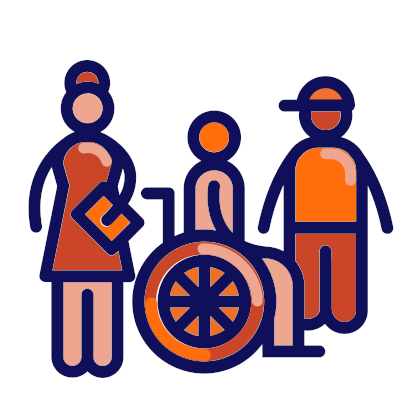Improving well-being at school

Since well-being has many facets, improving students’ well-being in schools requires a whole-school approach, involving both teachers and parents.
Schools should provide lessons focused on the responsible use of the Internet, the need to adopt a healthy lifestyle and how to prevent or cope with health problems, in collaboration with those involved, including health and social services, local authorities and civil society organisations.
Facts & figures
About 60% of school students report getting very tense when they study.[1]
Just over 60% of girls and 40% boys say they feel very anxious about doing tests at school, even when they are well prepared.[2]
Over 70% of parents say they would choose to send their children to a school with below-average exam results if students were happy there.[3]
What is well-being?
Well-being is the experience of health and happiness. It includes mental and physical health, physical and emotional safety, and a feeling of belonging, sense of purpose, achievement and success.
Well-being is a broad concept and covers a range of psychological and physical abilities. Five major types of well-being are said to be:
- Emotional well-being – the ability to be resilient, manage one’s emotions and generate emotions that lead to good feelings
- Physical well-being – the ability to improve the functioning of one’s body through healthy eating and good exercise habits
- Social well-being – the ability to communicate, develop meaningful relationships with others and create one’s own emotional support network
- Workplace well-being – the ability to pursue one’s own interests, beliefs and values in order to gain meaning and happiness in life and professional enrichment
- Societal well-being – the ability to participate in an active community or culture.
Overall well-being depends on all these types of functioning to an extent.[4]
“Having meaning and purpose is integral to people’s sense of well-being. Well-being involves far more than happiness, and accomplishments go far beyond test success.”[5]
Why is well-being important at school?
Well-being is important at school because schools have an essential role to play in supporting students to make healthy lifestyle choices and understand the effects of their choices on their health and well-being. Childhood and adolescence is a critical period in the development of long-term attitudes towards personal well-being and lifestyle choices. The social and emotional skills, knowledge and behaviours that young people learn in the classroom help them build resilience and set the pattern for how they will manage their physical and mental health throughout their lives.
Schools are able to provide students with reliable information and deepen their understanding of the choices they face. They are also able to provide students with the intellectual skills required to reflect critically on these choices and on the influences that society brings to bear on them, including through peer pressure, advertising, social media and family and cultural values.
There is a direct link between well-being and academic achievement and vice versa, i.e. well-being is a crucial prerequisite for achievement and achievement is essential for well-being. Physical activity is associated with improved learning and the ability to concentrate. Strong, supportive relationships provide students with the emotional resources to step out of their intellectual ‘comfort zone’ and explore new ideas and ways of thinking, which is fundamental to educational achievement.
Well-being is also important for developing important democratic competences. Positive emotions are associated with the development of flexibility and adaptability, openness to other cultures and beliefs, self-efficacy and tolerance of ambiguity, all of which lie at the heart of the Council of Europe Reference Framework of Competences for Democratic Culture.
What are the challenges?
One of the challenges of trying to promote young people’s well-being in school is the multi-faceted nature of well-being. There are a number of different types of well-being, all of which need to be promoted to some extent to create an overall sense of well-being in a person. So, it is not possible to improve students’ well-being at school through single interventions or activities. Rather it requires the development of a ‘culture’ of well-being throughout the whole school and the active involvement of the whole staff, teaching and non-teaching, which can be difficult to achieve.
The promotion of well-being may sometimes appear to conflict with other school priorities, such as academic standards. Unreasonably high expectations, a regime of constant testing or an over-emphasis on the importance of academic performance may actually undermine student well-being.
In many cases schools do not have the freedom to make the changes to school life which might most benefit student well-being. They may have little control, for example, over formal examinations and tests, the content of curricula, the length of the school day or the physical school environment.
Nor have schools control over the many out-of-school influences on student well-being. What happens in the home and the family, local communities or social media can have as much, if not more, influence on student well-being as anything in school.
Finally, developing a sense of well-being in students is made all the more difficult when school staff themselves do not have a positive sense of well-being. Well-being at work is strongly related to stress. Stress at work is related to workload, quality of professional relationships, level of autonomy, clarity about one’s role, availability of support and the opportunity to be involved in changes which affect one’s professional life. High levels of stress can lead to demotivation, lack of job satisfaction and poor physical and mental health, which has a knock-on effect on students’ own well-being.
How can schools get active?
Addressing student well-being at school begins with helping students feel they are each known and valued as an individual in her or his own right, and that school life has a meaning and purpose for them. This can be achieved in a variety of small ways, the cumulative effect of which can have a very powerful influence on students’ sense of well-being. These include:
- providing opportunities for all members of the school community to participate in meaningful decision-making in school, e.g. through consultations, opinion surveys, referenda, electing class representatives, student parliaments, focus groups, in-class feedback on learning activities, and an element of student choice in relation to topics taught and teaching methods used;
- developing a welcoming environment where everyone at school can feel supported and safe through access to meaningful activities, e.g. clubs, societies, interest groups and associations dealing with issues of concern to young people, including health;
- taking steps to reduce the anxiety students feel about examinations and testing through the introduction of less stressful forms of assessment, e.g. formative assessment, peer assessment and involving students in the identification of their own assessment needs;
- using teaching methods that contribute to a positive classroom climate and well-being, e.g. cooperative learning, student-centred methods, self-organised time, outdoor activities;
- finding curriculum opportunities to talk about well-being issues with students, e.g. healthy eating, exercise, substance abuse, positive relationships;
- integrating democratic citizenship and education for intercultural understanding into different school subjects and extra-curricular activities, e.g. openness to other cultures in Religious Education, knowledge and critical understanding of human rights in Social Science, empathy in Literature;
- introducing student-led forms of conflict management and approaches to bullying and harassment, e.g. peer mediation, restorative justice;
- improving the physical environment of the school to make it more student-friendly, e.g. new furniture and fittings, carpeted areas, appropriate colour schemes, safe toilet areas, recreational areas;
- encouraging healthier eating by providing healthy options in the school canteen, e.g. avoiding high amounts of sugar, saturated fats and salt;
- working with parents to enhance students’ achievement and sense of purpose in school, e.g. on healthy food, safe internet use and home-school communications.
Individual initiatives like these can be brought together at the whole-school level through a policy development process which ‘mainstreams’ well-being as a school issue. This means giving attention to the potential effects of new policies on individual well-being - of students, teachers and others. Addressing student well-being at school always goes hand in hand with action to protect the health and well-being of teachers and other staff at school.
[1] OECD (2017). PISA 2015 Results (Volume III), p.40. Students’ Well-Being. Paris, France: OECD Publishing.
[3] Cowburn & Blow, ‘Wise up - Prioritising wellbeing in schools’
[4] Psychology Today, January 2019.
[5] Hargreaves & Shirley (2018), ‘Well-being and Success. Opposites that need to attract’.
 Resources on Improving well-being at school
Resources on Improving well-being at school
 Related schools projects
Related schools projects
Address: Escola Básica Integrada de Ribeira Grande
Country: Portugal
Project: To Involve Project
 Working language during the project:
Working language during the project:
- Portuguese
 Themes of the Council of Europe project “FREE to SPEAK, SAFE to LEARN - Democratic Schools for All” covered:
Themes of the Council of Europe project “FREE to SPEAK, SAFE to LEARN - Democratic Schools for All” covered:
- Making children’s and students’ voices heard
- Improving well-being at school
 Competences from the Reference Framework of Competences for Democratic Culture (CDC) addressed and where / how they were integrated:
Competences from the Reference Framework of Competences for Democratic Culture (CDC) addressed and where / how they were integrated:
- Empathy
Promote debate after story telling that focusses on the recognition and appreciation of the motives, behaviors, desires and feelings of others.
Heighten empathy through practical, multisensory activities such as drawing, drama, and role play to complement the story telling.
Spark mindfulness activities that allow students to become more attentive and aware of their present thoughts, emotions and behaviour. The resulting focused attention and enhanced awareness facilitate students’ self-regulation and positive emotions such as happiness and optimism, as well as empathy, perspective taking and prosocial behaviour. - Co-operating Skills
Role-playing games that develop skills ranging from the ability to take turns and sharing to cooperation and teambuilding.
Games that appeal to teamwork. - Conflict-Resolution Skills
Games that promote assertive communication.
Debate alternative ways to resolve conflict based on stories with subsequent application and generalization to actual struggles in children's lives.
 Target group age range:
Target group age range:
- 5 - 11
 Level of education:
Level of education:
- Primary education
Short description of the project:
The To Involve Project, created in 2016, intends to promote development of socio-emotional competences, via mobilization and engagement of all educational elements, following a Whole School Approach (WSA). WSA consists of an approach based on establishing networks that integrate policies and practices pertaining to school organizational culture, opportunities cultivated in the classroom and by the curriculum, as well as partnerships fostered with educational community entities. To Involve Project calls on collaborative work involving all concerned: teaching and non-teaching staff, students, parents and families, community agents, among others.
The project was successfully approved in July 2018 by the Calouste Gulbenkian Foundation to function as Gulbenkian Academy of Knowledge. As Gulbenkian Academy of Knowledge, the project benefited from financial support and backing in the evaluation and monitoring process. Our methodology is supported by a theoretical framework developed from the typology of Social and Emotional Learning (SEL) programs. SEL programs lead to positive effects on targeted socio-emotional skills, along with attitudes about oneself, others and the school. The methodology consists of inclusive and universal intervention, aimed at all children in the classroom, yet with activities incorporating diversity, particularly the most vulnerable children.
As a Gulbenkian Academy of Knowledge, the project integrated experimental strategies capable of serving as a future reference for projects that create contexts to promote the development and evaluation of social and emotional skills.
In order to promote socio-emotional competences among children, teachers and technical staff have received accredited training (25h) to implement the European Resilience Curriculum (RESCUR) in the classroom context. The RESCUR sessions are implemented biweekly and have a duration of 90 minutes. To prevent burnout, to promote resilience and SEL in students, teachers have attended Systemic Coaching sessions and technical staff have received training in this area. Simultaneously, with the aim of promoting positive parenting, parental engagement and collaboration in the development of SEL in children, parents/caregivers have been invited by teachers to get involved with children in the classroom in SEL activities. They have also been invited to perform RESCUR home activities and to participate biweekly in family interaction groups for eight sessions.
 Aims/objectives
Aims/objectives
Our main goal is to improve mental health and educational success in 199 children aged 3 to 12 years old through SEL.
To achieve the main goal, we set 4 intermediate goals:
- 1) Teacher Training in the European Resilience Curriculum (RESCUR);
- 2) Implementation of sessions for students, which allowed the development of communication skills, problem solving and emotional regulation in 199 children (preschool and elementary school);
- 3) Promotion of positive parenting, parental involvement and collaboration in the development of socio-emotional skills in children; and
- 4) Social and emotional skills training for non-teaching staff
 Expected results/outcomes
Expected results/outcomes
We expected the following results for each of the intervention targets:
- a) Students: acquire communication skills (effective listening, understanding others, communicating ideas effectively and assertive conflict resolution); acquire problem solving skills (define a problem and find solutions, evaluate these solutions and make a decision, as well as apply this process in daily routine); acquire managing and regulating emotions skills (identify, recognize and express basic emotions, interpret one’s
- own underlying emotional and motivational states as well as those of others, and regulation of emotions).
- b) Teachers: voluntary adherence to the project, participate actively and increasingly autonomously in the advancement of social and emotional skills in the school context.
- c) Parents/caregivers: parents' adherence to implement the activities sent home, greater proximity to the school context; acquisition of positive parenting competencies.
 Changes
Changes
To measure student´s evolution throughout the school year, we surveyed teaching staff using a five-point Lickert Scale.
Regarding the development of Communication Skills, specifically Effective Communication, there was a high perception of change due to the ability to listen effectively (55%) and to understand the emotions in communication (60%). In relation to the ability to communicate ideas, cooperate and negotiate this change stood at 44%.
For assertiveness, the results point to a high change perception of 54.7%.
Under Problem Solving skills, in Preschool there is a high evolution in all items evaluated, namely the ability to define the problem and think of creative solutions (52.5%), to evaluate solutions and make a decision (50.9%) and to apply problem solving in practice (52.7%). In turn, in primary education the evolution in all items included is reasonable, namely 62.5% in the ability to define the problem and think of creative solutions, 49.3% to evaluate solutions and make a decision, and finally 63.9% to apply problem solving in practice. These results support the relevance of promoting these skills at an early age, demonstrating that it is possible to develop skills such as Problem Solving in children from 3 to 5 years old, using products and dynamics appropriate to the age group.
Under the Emotional Regulation skill, educators and teachers perceive a high evolution in the ability to identify and recognize the different basic emotions (75%), in the ability to express basic emotions (61%). In their ability to identify strategies for managing emotions, the perception of high evolution was 53%.
Educators / teachers, mainly responsible for the implementation of the sessions with the students, proved to be important promoters of the skills contemplated, having regularly encouraged their students to reflect and monitor their own learning, created the conditions for the practice of these skills and their integration in other curricular areas.
The goal of increasing the involvement of parents / caregivers in the promotion of children's socio-emotional skills was achieved, with a significant increase in their participation throughout the school year, with an average participation rate of 44% in the first actions, increasing to 78% in subsequent actions.
The results of the qualitative evaluation (focus group) demonstrate that in the perception of parents / caregivers the To Involve Project provided positive impacts not only on the school-family relationship and the student-family relationship, but also on themselves, as they consider sessions a learning opportunity and a source of emotional support.
The teachers also perceived impacts of the To Involve Project at multiple levels, namely in the school-family relationship, reporting greater parental involvement in the school context, establishing relationships characterized by greater respect between teachers and caregivers, and remark the recognition by caregivers of the important role of educators and teachers in their children's lives. In addition, teaching staff also emphasize the practice of mindfulness and the topics addressed as useful and beneficial tools in the management of their class groups.
 Challenges you faced
Challenges you faced
Although the teachers are strongly encouraged to embed the social and emotional competencies into daily classroom activities, in a structured way, so as to facilitate generalization and internalization, they find it difficult to do so without the support of the technical team (psychologists).
Supervisory work with teachers has been essential to ensure that they are able to strengthen the relationships with colleagues, students and parents, and sustain their own motivation, sense of efficacy and engagement.
 Time-frame of the project:
Time-frame of the project:
2016- ongoing
 Council of Europe materials on citizenship and human rights education used while preparing or implementing your practice:
Council of Europe materials on citizenship and human rights education used while preparing or implementing your practice:
European curriculum for resilience promotion (RESCUR), a resilience curriculum for early years and primary schools in Europe. RESCUR was designed as a universal and inclusive program to promote resilience related competences in children from 4 to 12 years old, giving, nevertheless, a special attention to vulnerable groups such as children with disabilities, special educational needs, children from minorities and refugees.







